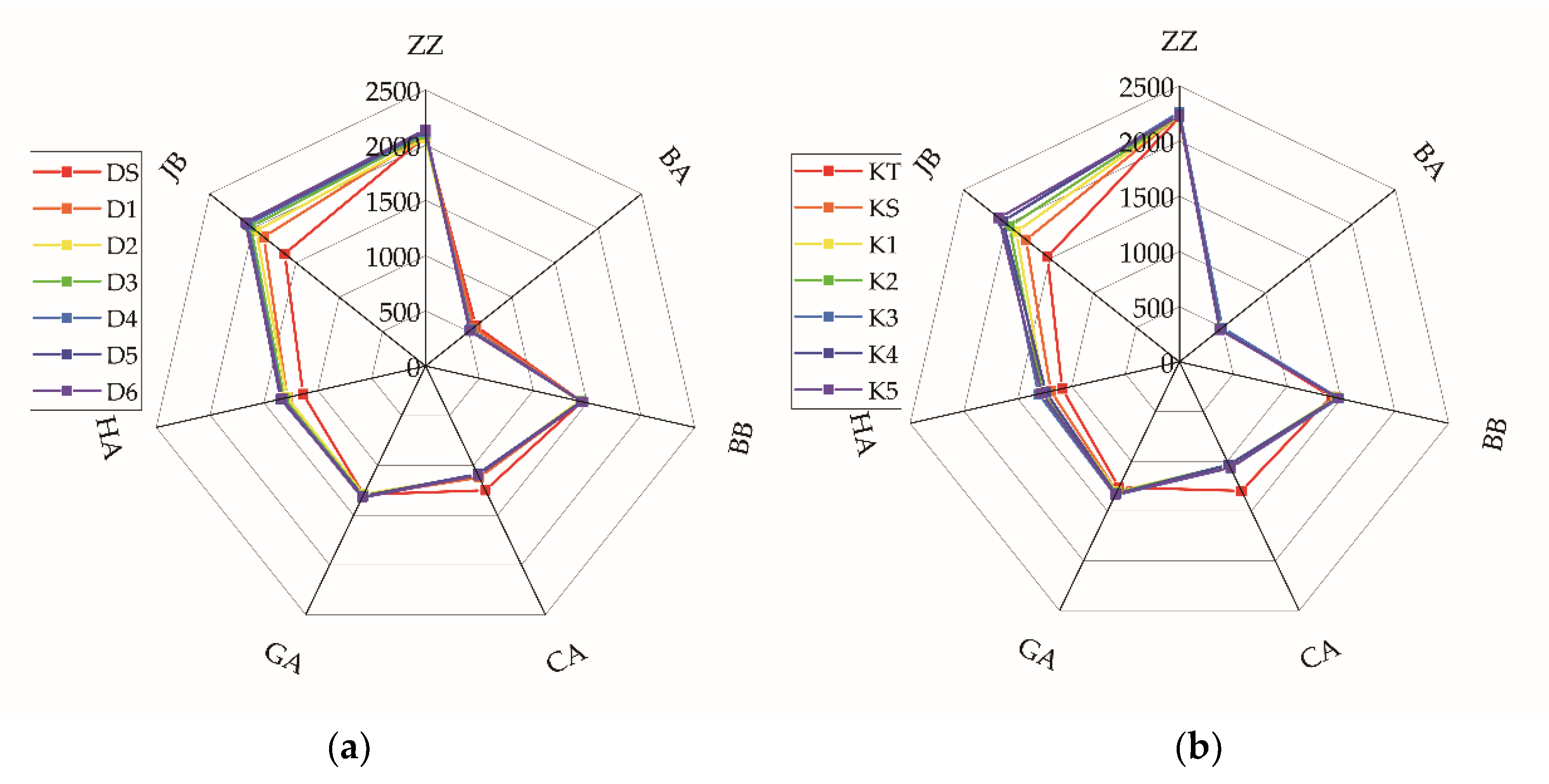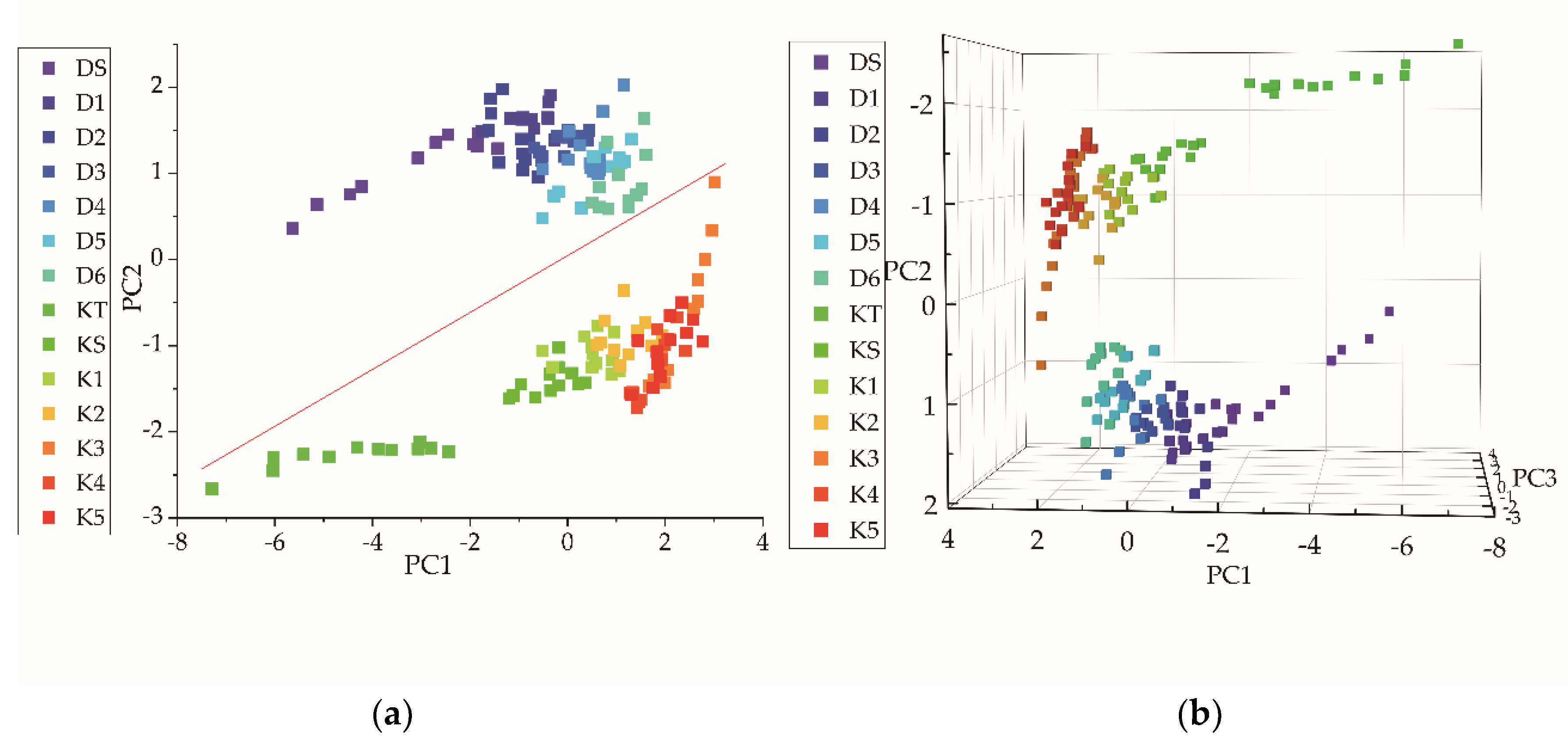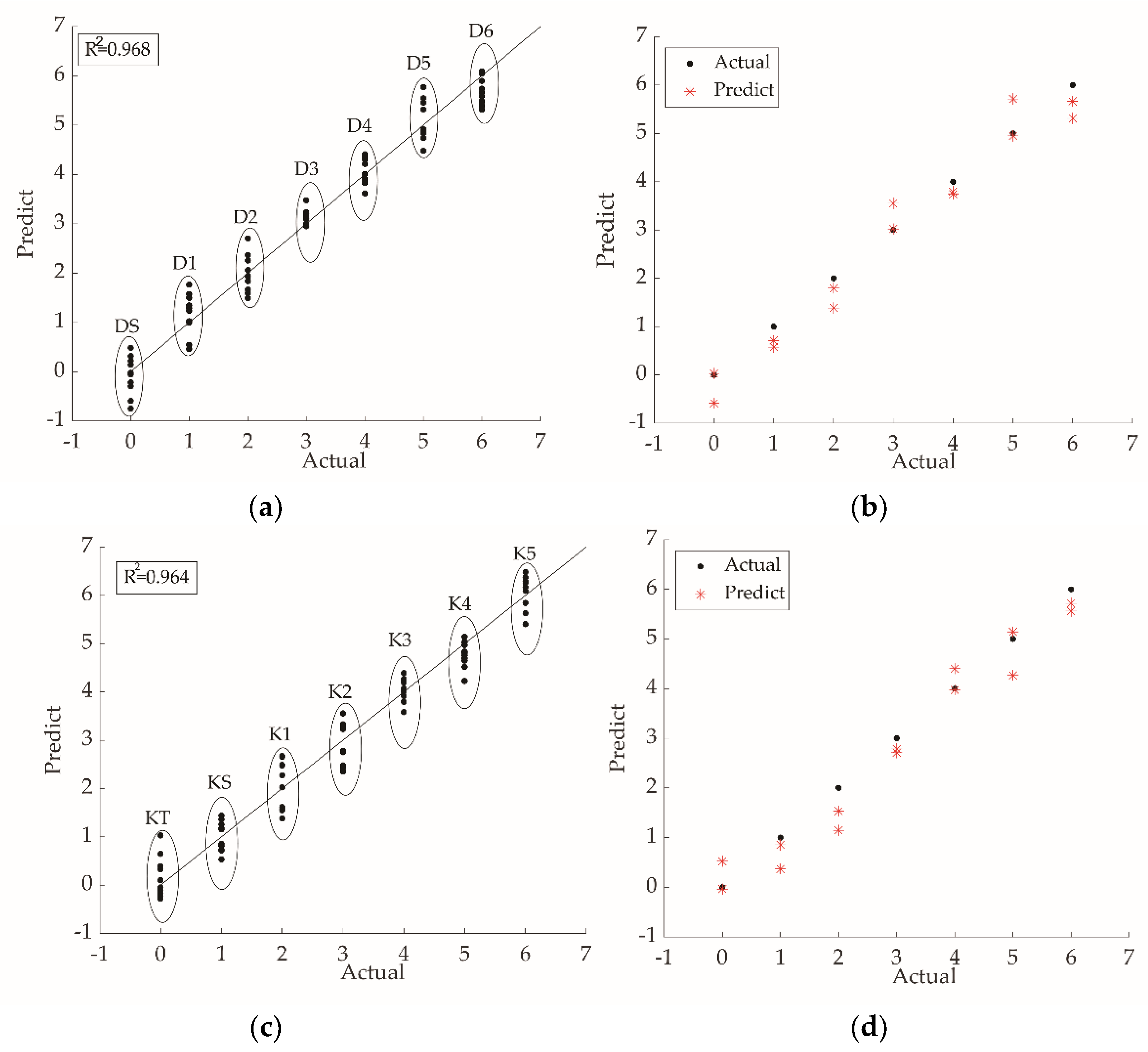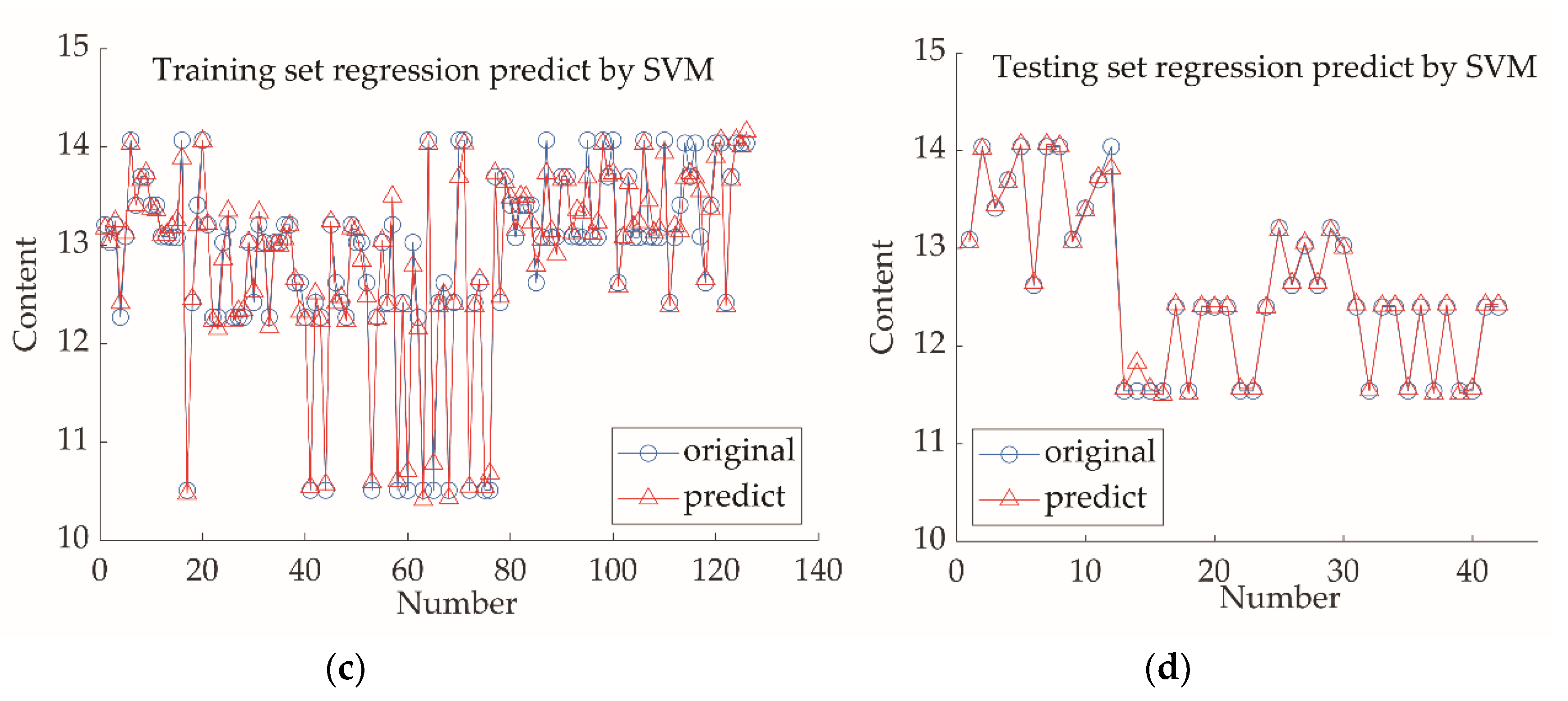1. Introduction
Black tea is the most commonly consumed tea type in the world. In China, there are three types of black tea, namely, Souchong black tea, Congou black tea, and broken black tea. Keemun black tea and Dianhong Congou black tea are varieties of Congou black tea. They produce very similar tea infusions that, commonly, are difficult to distinguish. They also present only subtle differences in tea grades, which does not help with their identification.
For a long time, tea grades and quality identification mainly relied on human sensory evaluation, which, however, may be biased by external and subjective factors. The traditional detection of tea biochemical components requires a lot of time and energy. To achieve a standardized and objective tea evaluation, it is necessary to introduce a digital assessment system.
The electronic tongue uses a sensor array to perform a qualitative or quantitative analysis of liquid samples through pattern recognition. It has been widely used to analyze food products, such as coffee [
1], wine [
2], milk [
3,
4], honey [
5,
6,
7,
8], juice [
9], and others [
10,
11]. Since 2000, a growing number of studies have focused on the use of the electronic tongue for tea analysis. The main ones are listed in
Table 1.
Previous studies showed that the electronic tongue is useful in tea classification, but few studies have applied it to distinguish similar types of tea. Some of the samples tested were purchased from supermarkets or retailers, were of assorted brands, had different origins, and were produced by diverse techniques. Most of these studies ignored the relationship between biochemical components of tea and electronic tongue response. In this work, we analyzed two similar types of Chinese Congou black tea, Dianhong Congou black tea, and Keemun black tea, using standard samples. Both types are characterized by seven grades. We showed the ability of the electronic tongue not only to distinguish tea types and grades but also to identify the biochemical components of different teas. Principal component analysis and discriminant analysis were used for type identification. Partial least-squares analysis, back-propagation neural network, discriminant analysis were used for grade identification. By support vector machine models, the tea biochemical compositions could be predicted by electronic tongue response.
3. Discussion
In this paper, the response values of different electronic tongue sensors for Congou black tea varied, with ZZ > JB > BB > BA. The response values of the sensors HA, GA, and CA were lower than those of the sensor BB but higher than those of the sensor BA. They varied depending on the samples’ grade (
Figure 1 and
Figure 2). Our results are different from those reported for green tea using the same electronic tongue [
16,
17,
26]. Chen et al. [
17] reported that the green tea response values of the different sensors varied in the order BA > CA > ZZ > JB > BB > HA > GA. Xiao et al. [
26] pointed out that the electronic tongue response values for Xihulongjing (a Chinese green tea) from the different sensors were in the order CA > ZZ > GA > JB > HA > BB > BA. Rodrigues et al. [
27] found that green tea presented three oxidation peaks, while black tea had two. Differences between green tea and black tea were also found using other types of electronic tongues because the processing technology of black tea and green tea is different, leading to significant differences in the biochemical content of the teas. Green tea is unleavened, it contains more polyphenols and amino acids. Black tea is fully fermented, with a low content of polyphenols, EGCG, EGC. Tea polyphenols and catechins mainly provide astringency, acerbity, and bitterness. Amino acids connected to the fresh and brisk taste, and others can also have bitter, sweet or sour taste. Caffeine provides the bitter taste. They are responsible for the fresh and brisk taste of green tea and the sweet and mellow taste of black tea [
15,
27,
28]. Different quantities of the components lead to different tea flavors and, consequently, to different response values. From the radar map (
Figure 2), the electronic tongue for both kinds of teas tended towards similar. Because the processing of two Congou black teas was the same and consisted of withering, rolling, fermenting and drying. Therefore, the response values determined may be typical of Chinese Congou black tea.
The electronic tongue response combined with the PCA and the DA could distinguish the two types of Congou black tea. The scatter plots of PCA (
Figure 3) and the DA (
Figure 4) showed that the samples of the two types of tea were situated in two areas, which clearly distinguished one kind from the other. The DA performed better. Although these samples were all processed according to the Congou black tea technology, they came from different tea varieties; also, there were certain small differences in their processing. For example, the strength and time of rolling changed the amount of polyphenols that can be dissolved. The degree of oxidation was also different. There was a marked difference in the biochemical composition of the two types of tea (
Table 2 and
Table 3 Table 2;
Table 3). The contents of water extract, EC, and ECG of Dianhong tea were higher than those of Keemun tea, but the contents of caffeine, EGCG, GCG, and EGC in Kemmun tea were higher than in Dianhong tea. Furthermore, the average response values (
Figure 2) of the sensor ZZ and BA varied significantly for the two types of tea. The value of the sensor ZZ for Dianhong tea was lower than that for Keemun tea, and the value of the sensor BA for Dianhong was higher than that for Keemun tea. The electronic tongue sensor ZZ is sensitive to sour and sweet tastes, while the sensor BA is sensitive to the sour taste [
11]. The sweet-tasting substances in tea mainly include soluble sugar and certain amino acids. Sour substances form in black tea during fermentation, and mostly include some amino acids, organic acids, and gallic acids. Therefore, small differences in the fermentation procedure resulted in some different response values for these two Congou black teas. For the sensory evaluation, Keemun tea was sweeter and more fresh. It can be seen that the response values of the electronic tongue were consistent with the results of sensory evaluation. The sensor ZZ and BA appeared the most effective in identifying the type of black tea.
For grade discrimination, the accuracy of classification of all samples by the DA (
Table 6) and the BPNN (
Table 8) was greater than 95.00%. Li et al. [
20] had previously successfully classified Tieguanyin (a kind of Chinese oolong tea) by BPNN with good results. Mondal et al. [
29] used a pseudo-outer-product-based fuzzy neural network to classify four black tea grades. The sample distribution of the PCA (
Figure 3) and the DA (
Figure 4) showed sample distribution according to the tea grades. This reflected the intrinsic distinction of tea. From
Table 2 and
Table 3, the content of water extract, amino acids, CG, and GC were higher in higher-grade. Other biochemical content varied in different grades [
30]. In terms of human sensory evaluation (
Table 4), a lower taste score corresponded to lower-grade samples. Gao et al. [
31] previously used PCA to identify Pu -erh tea (a kind of Chinese dark tea) and showed that each grade could be distinguished by PCA. However, in this study, the PCA scatter plot clearly distinguished only the highest grade (
Figure 3). The highest- grade samples of each tea type arranged loosely in the scatter plot without overlapping with other samples. Loose distribution of PCA scatter plot were also observed in other grade classification studies [
18,
19,
26,
32,
33,
34]. Because extraction comparison of PCA was based on the original data rather than the category [
32]. The DA region graph (
Figure 4) showed that different grades could be distinguished well and samples of the same grade clustered in the centroids, without overlapping with other samples. In
Figure 4, higher values of the Function 2 axis corresponded to lower grades. The PLS model was used to predict the grade of each sample of tea. The R
2 of two tea types were both above 0.95, and the prediction results for Dianhong tea were better. In addition, it can be seen from the radar map (
Figure 2) that the responses of the sensor JB, HA, and CA varied significantly for different tea grades. The response values of the sensor JB and HA decreased for samples of higher grades. The sensor CA showed the opposite trend. The sensor JB and HA are sensitive to the sour taste, while the sensor CA is sensitive to both the sour taste and the sweet taste. Generally, high-grade black tea has a pleasant sweet mellow taste, low-grade black tea presents bland taste. Combined with the sensory evaluation (
Table 4), the overall score and quality of tea taste decreased with grade reduction.
4. Materials and Methods
4.1. Sample Preparation
Standard samples of Dianhong Congou black tea and Keemun black tea corresponding to seven grades were obtained from Yunnan and Anhui provinces. Dianhong Congou black tea of special grade and grade of Grades 1 to 6 were marked as DS, D1, D2, D3, D4, D5, and D6. Keemun black tea classified as into Teming, special grade, and Grade 1 to Grade 5, indicated as KT, KS, K1, K2, K3, K4, and K5. All samples were packed with brown paper and stored at 4 °C before testing.
4.2. Biochemical Composition Detection
The tea biochemical composition was detected according to the National Standards of the People’s Republic of China (modified ISO 1573: 1980, ISO 9768: 1994, ISO 10727: 1995, ISO 14502-1/2: 2005 and GB/T 8314-2013). Twelve items were analyzed: water extract, total tea polyphenols, amino acids, caffeine, catechin (C), epicatechin (EC), gallocatechin (GC), epigallocatechin (EGC), catechin gallate (CG), epicatechin ga1late (ECG), gallocatechin gallate (GCG), and epigallocatechin gallate (EGCG).
4.3. Tea Sensory Evaluation
Tea sensory evaluation was performed following the National Standards of the People’s Republic of China (GB/T 23776-2018) by professional tea tasters. The grading standard for congou black tea was based on a total score of 100, with 25% accounting for the appearance of dry tea, 10% for liquor color, 25% for aroma, 30% for taste, and 10% for infused leaves.
4.4. Electronic Tongue and Data Acquisition
A potentiometry electrochemical electronic tongue (α-Astree II; Alpha MOS company, Toulouse, France) was employed in this experiment. It included an array of seven chemical sensors (ZA, BB, BA, GA, HA, JB, and CA) and one Ag/AgCl reference electrode. Each sensor was coated with a different molecular film, which had different adsorption properties, discriminating different tastes. Each sensor had cross-sensitivity to bitterness, savory, saltiness, sourness, and sweetness. The potentiometric difference between the sensor and the Ag/AgCl reference electrode was recorded as the response signal. Tea preparation for electronic tongue detection was as follows: 3 g of dry tea was brewed in 150 mL of freshly boiled pure water for 5 min, and the tea infusion was then carefully separated into an empty bowl. The filtered infusion was allowed to cool down for at least 30 min until it reached room temperature (25 °C). After then, 80 mL of infusion was transferred into a special beaker for electronic tongue detection. In this experiment, each sample was tested for 120 s in order to obtain consistent results. The software recorded the response value of each sensor per second, and the last second of data was used as the original data for statistical analysis. Each sensor was cleaned for 15 s during the continuous test of the same sample, and for 120 s before testing another sample in order to prevent cross-contamination between samples and ensure the cleanliness of the sensor [
26].
4.5. Data Analysis
One-way analysis of variance was used to test the variance of tea biochemical components in the different samples of the two tea types. Principal component analysis derived a few principal components from the original variables so that they retained as much information as possible about the original variables. Discriminant analysis and back-propagation neural network were used to reflect the accuracy of the type and grade of electronic tongue prediction. Partial least-squares analysis showed the grade prediction effect for each type. The support vector machine model further confirmed the relationship between electronic tongue response values and tea biochemical components. The figure reposting the electronic tongue response values and the radar map were obtained using Origin 2017; one-way analysis of variance, principal component analysis, discriminant analysis and back-propagation neural network were performed by SPSS 25.0, while partial least-squares analysis and support vector machine were performed using Matlab 2019a.
5. Conclusions
In this paper, we examined the electronic tongue response for Congou black tea. The response values of the electronic tongue’s sensors for Congou black tea varied according to the order ZZ > JB > BB > HA/GA/CA > BA (the response values of the sensors HA, GA, CA varied among samples). The response values of the sensors ZZ and BA were related to the type of Congou black tea. The sensor ZZ showed a higher response value for Keemun tea, and the values recorded for Keemun tea samples at different grades were all above 2200. The sensor BA showed lower response values for Keemun tea, which were all below 500. The response values of the sensor BA for Dianhong tea were all above 500. The electronic tongue combined with PCA and DA could successfully distinguish the two tea types. For grade discrimination, the response values of the sensors JB and HA decreased for high-grade samples, while the response value of the sensor CA increased as the sample grade increased. The electronic tongue combined with PLS, DA, and BPNN could effectively identify the tea grade. Among the different pattern recognitions obtained, the DA region graph could effectively discriminate both type and grade simultaneously. For quantitative analysis, the SVM model showed a good correlation between the seven electronic tongue sensors’ response values and the biochemical components of Congou black tea. Therefore, this model can predict the content of the biochemical components of tea on the basis of the response values of the electronic tongue. From the above analysis, the electronic tongue could serve as an effective tool for classification of similar Congou black teas.












